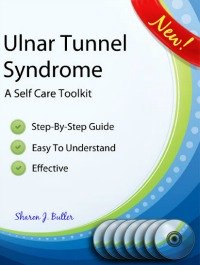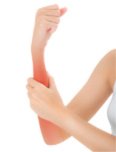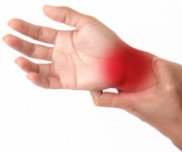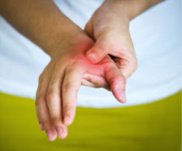Ulnar Tunnel Syndrome Self Care
As with all repetitive strain injuries, Ulnar Tunnel Syndrome, also known as Cubital Tunnel Syndrome, is a condition that develops based on how the body is currently being used, its history of previous injury and trauma and the unconscious habits that might be adding to strain along the ulnar nerve pathway. You will accomplish the best results from your self care program if you address each of these aspects and work with them until they are resolved.
Stretching Is The Key To Success
Because the symptoms of Ulnar Tunnel Syndrome are all caused by changes in the fascia surrounding the ulnar nerve, and because stretching is the best way to correct adhesions and other changes to the fascia, then stretching becomes your best option for success.
The only problem is, it is difficult to find a stretch position that adequately reaches the inside of the ulnar tunnel. For this reason, it is also helpful to include stretches to all the other parts of the ulnar nerve pathway. Often, if performed correctly, any release taking place along this pathway will spread along the nerve to reach the ulnar tunnel.
Areas that can benefit from this kind of careful stretching include the armpit, the seam between the biceps and triceps muscles in the upper arm, the tissue along the ulna bone in the forearm and the wrist. The best stretches to reach these areas are included in the Ulnar Tunnel Syndrome Self Care Toolkit.
"Your website has been on my radar since I sort of self-diagnosed an ulnar nerve problem almost 2 years ago - I googled madly all of my symptoms and found your site, and found it very helpful. I kept referring back to it when symptoms flared up, b/c I felt less crazy, but was working w/ a hand therapist at the time. Yours was the only place that approached things from the big picture and got all of the bizarre details right. Most medical professionals that I have met have been loathe to "speculate" beyond their particular area and had no idea how to address different symptoms.
It seems hard for many people in our world to understand things from your more holistic, gentle perspective (our loss) - we'd much rather turn to surgery rather than the subtleties of listening to what is happening, and taking some responsibility for it. I have tried to view my own injuries as my body's invitation to pay more attention and to release, let go, surrender - none too easy!"
Susan K.
Habits That Irritate the Ulnar Nerve
I know it can be annoying to have to make changes in how you have become used to doing things. The problem is, if you have developed Ulnar Tunnel Syndrome, chances are its those very habits that are causing your symptoms. Paying attention to how you are using your body will often result in a significant reduction of your symptoms.
There are several common mistakes people make when it comes to postures and motions that add strain to the ulnar tunnel region of the body. Eliminating those motions or postures as much as possible will help in your effort to restore normal and natural function.
Resting Your Arms On Armrests
The first common habit that will almost always end in injury to the ulnar nerve and compression of the ulnar tunnel is if you rest your elbow on an armrest or on a table, workbench or desk.
Think about all the furniture you use throughout your day. Become aware of where you are resting your arms while at work or at home. Armrests on your office chair might seem very comfortable, but using them puts pressure on the ulnar tunnel or on the path of the ulnar nerve as it travels through the forearm.
Resting your elbow on a tabletop or desk will also compress the ulnar nerve, right at the tunnel itself.
Pressure on the ulnar nerve at the same time you are using your hands to type, assemble objects, eat dinner or use your hand actively in any other way will accelerate the development of ulnar tunnel symptoms and adhesions. The safest option is to rest your arms in your lap when you are not using your hands, avoiding armrests and desktops altogether.
While working, it is essential that you allow your arms to float over your work surface rather than leaning on your elbows.
Try lowering your armrests so they no longer make contact with your arms when you are sitting up straight. If you find you simply cannot break that habit, try switching to a chair that doesn't have armrests, like a steno chair.
Also be aware of your armrests at home. Sofas and recliners can be very problematic for people with Ulnar Tunnel Syndrome. Even though these armrests are fully padded, they can still put pressure on the ulnar nerve, especially from the elbow down to the wrist.
Another way armrests can be a problem is because they force you to hold your arm away from the side of your body. In this case, it isn't the pressure on your ulnar nerve that is the problem. It is the fact that you are holding your arm away from your sides, often for long periods of time. This gives the tissue plenty of time to shorten along the outside of your arm and this alone can create a whole host of symptoms related to the ulnar nerve.
I hate to be the bearer of bad news but to truly recover from Ulnar Tunnel Syndrome, you simply have to give up armrests until your symptoms are fully resolved.
Stressful Ways You Use Your Arms
Another common mistake people make that can promote Ulnar Tunnel Syndrome is when the arms are held away from and forward of the body.
This posture causes a contraction of the muscles that have to hold up the weight of your arms. If this pattern is repeated often enough, or held long enough, the ulnar nerve can get caught in the tightened fascia and bring about the symptoms related to Ulnar Tunnel Syndrome.
Often, the placement of desktop accessories can force this posture so it is very important to take a new look at the placement of your computer keyboard, mouse, and other equipment on your work surface. Make adjustments so you can easily reach the keys on your keyboard, your mouse and any other tools you use in your work without having to reach forward or pull your upper arms away from the sides of your body.
If you don't work at a desk, the same principles apply to you too. Pull your work close to the front of your body, relax the tension in your shoulders, and make sure that your posture is as close to optimal as possible.
Hairdressers are forced to hold their arms up and away from their bodies while cutting and styling hair. Any job that requires that objects be held or carried forward and away from the body, like movers, truck drivers, etc. can also experience similar stress to their ulnar nerves.
Things You Can Do To Help
While stressful activities required by your job are not often changeable (there are only so many ways you can lift and carry a box, for example), what you do with your arms between activities becomes extremely important. The best option is to practice a gentle stretch that releases tissue throughout the ulnar nerve pathway. Review the diagram showing the ulnar nerve pathway to see the areas that need to be stretched.
One of the easiest ways to stretch this pathway is to hold your arms out to the side and walk through a doorway. You can vary the height of your arms from straight out to the side and all the way up to straight overhead. Just continue to move your torso through the doorway while keeping your arms pressed against the door frame. Only hold this position for 10 seconds or less.
If you can't get away from your work to stretch in a doorway, then simply raise your arms overhead and stretch upwards as far as you can. Bending and flexing your torso by an inch or two can also add to the stretch. Just be careful not to overdo it!
If stretching is not possible, some other options might be acceptable for reducing the effects of Ulnar Tunnel Syndrome. Simply dropping the arms by your sides, letting them hang with their full weight for a few seconds can be very helpful for reducing strain through the ulnar nerve pathway. Make sure you release any tension in your shoulders to get the most out of this stretch. It will often feel like a deep ache until the majority of the tight tissue has released. Just limit the time you spend to 15 seconds or less.
Reversing Habits And Unconscious Patterns
You can also figure out how to completely reverse your habitual holding pattern so the tissue is relieved.
Let’s look at a hairdresser, for example.
His or her arms are normally away and forward of the body as they work. The hands are holding a small object (scissors or comb) with the fingers curled in a pinching motion. The reverse of this would be to open the fingers fully, raise the arms over head and behind the head with the wrists bent away from the palm.
Brief stretches of this nature can go a long way to relieving the static strain caused by the posture of haircutting.
Experiment to see if you can come up with a reverse posture for your most common hand and arm positions. Check out The Reverse Stretch for more information.
Unconscious ways we use our hands and arms can be especially damaging, because we are unaware of what we are doing. This leads to a repetition of the stressful activities any number of times throughout the day. Adhesions will be the result. Not good.
It is very important to try to identify the stressful and unconscious ways that you are using your body. One clue might be if you feel discomfort while doing some activity, or holding your body in a certain way. Pay attention to see what you are doing with your arms at those times to see if something can be eliminated or changed to produce less stress and discomfort.
You may also find that you adopt stressful holding patterns based on how you use your arms at work. For example, if you have a habit of resting your elbows on a desk, you might discover that you also rest your elbows on the ledge of your car window, or on a high armrest on your sofa at home.
Breaking stressful habits at work alone are often not enough. You must also address the other times when your arms might be under stress. Take time to think about how you are using your arms for all of your waking hours and you will be surprised at the number of stressful patterns you discover.
Old injuries and traumas, plus the current ways you use your arms can lead to the development of adhesions, or stuck places, along the ulnar nerve pathway. Adhesions are best reduced or eliminated by gentle stretching along the entire nerve route. This includes around and under the shoulder blades, through the entire armpit area, the upper arms between the biceps and triceps muscles, the elbow, the outer forearm, throughout the wrist and into the hand.
How To Stretch To Release A Stuck Nerve
Adhesions are places where the nerve is under unusual and severe stress. You must be careful not to add more stress to the nerve as you stretch.
Releasing an adhesion is similar to removing a sticky label from a glass jar. You lift a tiny corner, then go to another place on the label and lift an edge there. You keep working around the label until it releases fully.
The same thing applies to releasing an adhesion that is trapping a nerve. Essentially, you “tease” the adhesion loose by working around it from all directions. You release a little bit here, then a little bit there, constantly working on all the areas that lead up to the adhesion. With care, the adhesion will fully release, leaving the nerve completely unencumbered and able to function normally.
A simple rule of thumb is to limit any stretch that affects a nerve to just 10 seconds. I know that seems to be a ridiculously short period of time, but it works if you add the following step. Do your 10 second stretch (this will often cause you to feel nerve symptoms like numbness or tingling while you do the stretch), then stop and put your hands in your lap and count off 60 seconds.
It is the rest period following the stretch which gives the body time to adjust and make changes. It is also the part of the stretch that prevents further damage to the nerve.
Careful attention to the current condition of your arms and how you use them, and to careful, gentle stretching along the ulnar nerve pathway will lead to ultimate success. Skipping any part of this process will leave certain stressors in place and will reduce the overall effectiveness of your recovery.
Be open minded as you explore the use of your body and the sensations that are created as a result. You will be better off for it in the long run. Recovery is possible. Stick with it!
To continue learning about Ulnar Tunnel Syndrome, visit the following sections:
Ulnar Tunnel Syndrome Symptoms
Click the block below that most closely matches your injury for more information and to find the Toolkit we offer to help you in your recovery.








